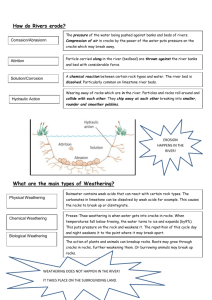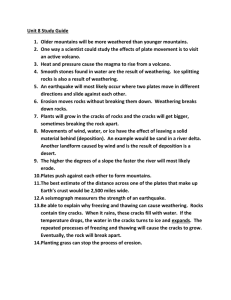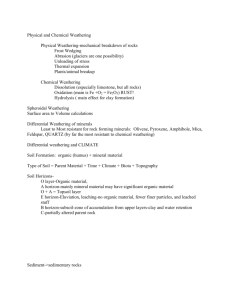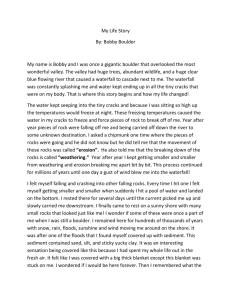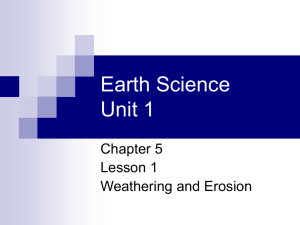Processes - Historic Cemeteries Conservation Trust of New
advertisement
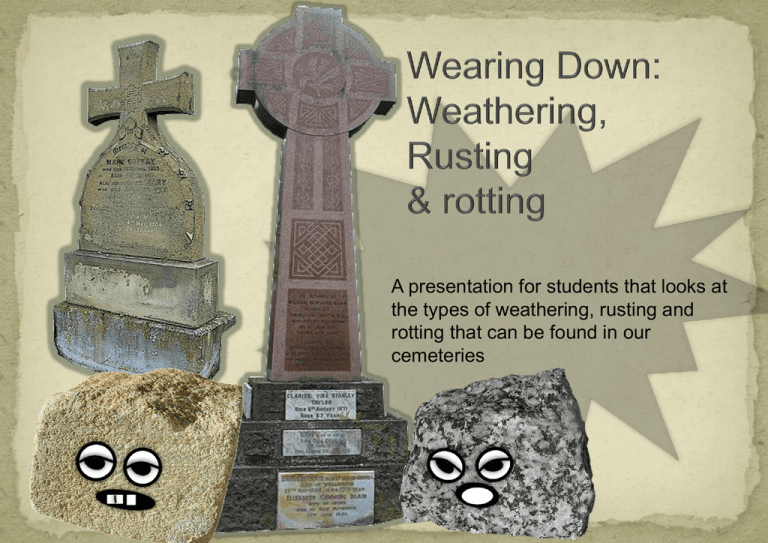
A presentation for students that looks at the types of weathering, rusting and rotting that can be found in our cemeteries The breaking down of rock is called weathering. There are two types of weathering. Most weathering is the result of both kinds. Different rocks weather at different rates depending on how hard they are. How hard they are depends on what they are made of. Chemical weathering is the chemical breaking down of rocks. When chemical weathering happens, a new substance is made. There are many different minerals in rocks. When water and air react with these minerals the new minerals formed are usually softer and the rock begins to crumble. Limestone and marble are made of calcium carbonate. A special type of weathering occurs with limestone and marble. Carbon dioxide in the air reacts with rainwater to form carbonic acid Carbon Dioxide + water carbonic acid. Limestone and marble react with acid so when this acidic water seeps into cracks and fissures it can dissolve quite large amounts eventually turning into caves and archways. Limestone is a soft sedimentary rock, prone to chemical weathering. Example 1 shows delamination on the surface of the stone. The surface is lifting and flaking around the inscription. Example 2 shows weathering on the carved edges of one side of the inscription plaque. 2 1 Images show a combination of chemical and physical weathering on this memorial in Dunedin’s Southern Cemetery. The northern face of this monument may have been worn away with water turning the calcium carbonate into carbonic acid. It is now a warm roosting site for sparrows who are contributing to the wear. Slowly over time the calcium carbonate reacts with carbon dioxide in the air or in rainwater to form carbonic acid. The acid wears away the marble from around the inserted lead letters gradually leaving them slightly proud of the surface stone. More and more water gradually wears the marble away around the lead pegs and the letters gradually come loose. Can you work out what factors affect how quickly some rocks are attacked by acid? Choose a factor to investigate. This might be temperature or perhaps how strong the acid is. Are there other factors to consider? How will you measure the rate of reaction? How will you make it a reliable test? How will you make sure your tests are safe? How will you record your results? What equipment will you need? Temperature of Time to collect acid (0C) gas Limestone chips /or marble chips (size of chips Concentration of acid (M) Time to collect gas might be a factor to investigate?) Dilute hydrochloric acid Bunsen burner, tripod, gauze & heatproof mat Thermometer Balance or digital scales Timer Flask with stopper and delivery tube Basin and Measuring cylinders Granite is formed by the solidification of magma underground. It is called an igneous rock. Granite often contains cracks and joints. Water seeps into the cracks and some of the minerals in the granite gradually turn to clay causing the granite to crumble. This is a very slow process and there is little evidence that headstones made from granite are starting to weather chemically. When the physical weathering of rocks happens no new substances are made. Rocks instead are broken into smaller and smaller pieces in a variety of ways that include temperature changes, freezing and thawing and plants. Repeated heating and cooling of rocks can cause cracks to form. During the day the part of the stone facing the sun heats up more quickly than the side facing the shade, and expands. At night the sunny side of the stone cools and contracts. The continual expansion and contraction eventually causes cracks in the rock. This kind of weathering is sometimes called onion skin weathering or exfoliation and can also be a cause of the delamination seen in slide 5 on the limestone headstone. Water gets into cracks in rocks. When water freezes it forms ice. When water begins to freeze it expands. Water between 4oC and 0oC expands. A lump of ice has a greater volume than the liquid water that it was made from. Freezing causes expansion of cracks and splitting or spalling of headstones which can cause even greater damage in future freezing and thawing. Fill the bottle with water right to the top. Screw on the lid tightly. Place the filled bottle in the ice-cream container and fit the lid. Place in the freezer over night. What happens to water when it freezes? Try this experiment at home. What equipment will you need? Small plastic or glass bottle with tight fitting lid Water Freezer Ice cream container with fitting lid. Describe how the bottle and water look next morning. The base of this sandstone memorial is beginning to fracture and flake on the sunny side of the memorial. Cracks are running parallel and at right angles to the surface. As the cracks open up water enters and undermines the stone especially in freeze thaw situations. Plants cause physical weathering. Some of the seeds may fall, be blown, or dropped by birds into cracks in rocks and develop into seedlings. As the tree grows, the roots act like a crowbar wedging rocks apart. Windblown or bird dropped seeds often grow unnoticed in cracks and can remain safe from weedkillers. When the trees become larger the roots can undermine the headstone foundations, and trunks can push and displace the headstone, or even subsume it completely. Left: Foetid iris and holly growing in cracks between and behind headstones. Above: Agapanthus is a major nuisance at an Auckland cemetery. Lower left: Ivy clings by growing into the surface of softer stones and can never be completely cleaned. A wide variety of mosses, lichen and fungi can be found growing over cemetery headstones. Although lichens are usually the first living organisms to colonise rocks the process of wearing down the stone is very slow and they do less actual damage to the stone than some cleaning processes. A species of encrusting lichen called Xanthoria ligulata commonly found on coastal rocks. Mosses can be found colonising a range of different stone types especially in areas where water accumulates or pools. Limestone is a porous rock that retains water. Limestone headstones that are lying with their backs in contact with the ground are often covered in a thick layer of moss in damper areas. Red or black staining on white marble detracts from the look of the headstone . The red discolouration is caused by lichen staining which emanates from the microscopic growths which inhabit the spaces behind the lead letters. The black discolouration is caused by a fungus which grows on the surface of the marble. Xanthoparmelia tasmanica is the botanical name for a pale green lichen that thrives in damp urban environments. It can be found growing on rocks, tree trunks and roof tiles, as well as on asphalt and is a common lichen found in our cemeteries. Various lichens including the very common Xanthoparmelia tasmanica grow over the surfaces of headstones making them difficult to read inscriptions. The stones in the cemetery are also open to other types of wear and tear. One of the most common is the gradual movement of soil down a steep slope. Sometimes the headstone and the corner posts will all shift to the same degree. Another is uneven soil compaction. After a burial soil was used to refill the hole but this was not compacted. Over time this uncompacted soil settles and creates sinkage. In many places cemetery headstones are affected by being located in low lying swampy places. Some older cemeteries were not developed with adequate field drains. Some of the soil creep and compaction problems can be due to a lack of, or poor drainage arrangements. Deliberate vandalism is a problem in many cemeteries. Examples from left include… Whole or parts of memorials can be smashed. Graffiti painted or incised on headstones Marble decorations deliberately chipped off Stelae pushed over Examples of a range of chemical and physical weathering of rocks can be found in almost all of our cemeteries. The natural processes of wearing away and breaking down of cemetery materials is occurring all the time. Maintenance and conservation of our cemeteries is an important and ongoing task if the historic cemetery is to remain for future generations. For homework visit http://www.cemeteries.org.nz/ and click on the left hand link to “Cemetery Conservation.” Assign problems from the slide show or have groups or individual students choose to investigate and find a possible solution from the site. Revisit each of the slides and encourage the class to discuss solutions to some of the problems in this slide show. Discussion: What are the solutions to some of these problems?
